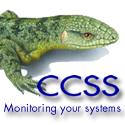CCSS has announced the general availability of a guide that identifies the Top Five Most Expensive Disk Issues impacting IBM i and Power System users–and the most effective means of guarding against these problems. The guide was produced in response to the industry’s urgent need to economize on resource expenditures in the wake of the credit crunch and subsequent recession, and it serves as a best practices roadmap for eliminating unnecessary disk expense and maximizing efficiency on the System i.
Ray Wright, president and CEO of CCSS, says guides such as this form an integral part of the company’s overall support services, “Our primary responsibility for our own product innovations, support, training and knowledge sharing is for the benefit of our existing customers, but beyond that, we’re also seeking new channels and means of sharing our experience and expertise with the wider System i community. It’s an important part of driving the development in our field of performance and message monitoring and being an active participant as the industry continually evolves.”
For many environments, a DASD spike is a warning that the system is struggling with another underlying issue that may not be immediately apparent. For IT managers, the challenge is always two-fold: identify the runaway DASD and then isolate the cause for resolution. Problems that consume disk are among the most expensive to contend with because the burden of cost is derived from multiple elements. In addition to the purchase of additional disk, itself a costly resource, a company with issues impacting disk may also have to account for additional man hours that may be required to carry out an investigation as to the origin of the problem. Furthermore, productivity could be compromised if the system performance degrades or there may be financial penalties for associated SLA breaches. In the most disastrous cases, there is also the added expense of a potential downtime situation.
Real-time disk monitoring can help to immediately identify threats to disk resource and give users greater awareness of an escalating situation that requires immediate attention. The guide from CCSS draws on the real-world experiences of system managers across a broad range of industries to identify the five most likely causes of runaway DASD. The top five disk ‘hit list’ serves as a useful reference point and tackles each area in turn to evaluate the impact on disk if this problem was left unchecked. Potentially, problems arising from any system object could trigger a disk consuming event. The "hit list" examines issues in the following areas: Journal Receivers; Temporary Storage; ASP; Important Files and Looping Jobs as these have, in the experience of Systems i users, typically been at the source of issues most frequently.
In one example given by the guide, a simple inactive journal receiver illustrates the damaging consequences of such a seemingly small issue. Left unchecked, the inactive receiver first has the potential to degrade system performance and impact the user community from their essential tasks. A rapid consumption of DASD could later result in a failed High Availability switch over, leading to lost data and a breach of regulatory compliance and the associated cost of downtime.
The "best practice" recommended to guard against such situations involves real-time insight and monitoring of these five areas so issues can be resolved immediately before they escalate to a system-threatening level. A combination of thresholds and alerts to govern these parameters will ensure managers are on a pro-active footing and can take a non-DASD-consuming response where possible. For example, managers could choose to save off a looping receiver onto tape to spare the DASD, which would meet their regulatory compliance in a much more cost efficient way, until the problem is resolved.
To download the guide in full, please visit:
http://www.ccssltd.com/resources/best-practice.php
Or join the CCSS Linked In Group:
http://www.linkedin.com/groups?mostPopular=&gid=1771585
For more information on CCSS, Disk Monitoring and QSystem Monitor, visit:
http://www.ccssltd.com/products/qsystem-monitor/features.php?id=dasd-ifs-monitoring





















 More than ever, there is a demand for IT to deliver innovation. Your IBM i has been an essential part of your business operations for years. However, your organization may struggle to maintain the current system and implement new projects. The thousands of customers we've worked with and surveyed state that expectations regarding the digital footprint and vision of the company are not aligned with the current IT environment.
More than ever, there is a demand for IT to deliver innovation. Your IBM i has been an essential part of your business operations for years. However, your organization may struggle to maintain the current system and implement new projects. The thousands of customers we've worked with and surveyed state that expectations regarding the digital footprint and vision of the company are not aligned with the current IT environment. TRY the one package that solves all your document design and printing challenges on all your platforms. Produce bar code labels, electronic forms, ad hoc reports, and RFID tags – without programming! MarkMagic is the only document design and print solution that combines report writing, WYSIWYG label and forms design, and conditional printing in one integrated product. Make sure your data survives when catastrophe hits. Request your trial now! Request Now.
TRY the one package that solves all your document design and printing challenges on all your platforms. Produce bar code labels, electronic forms, ad hoc reports, and RFID tags – without programming! MarkMagic is the only document design and print solution that combines report writing, WYSIWYG label and forms design, and conditional printing in one integrated product. Make sure your data survives when catastrophe hits. Request your trial now! Request Now. Forms of ransomware has been around for over 30 years, and with more and more organizations suffering attacks each year, it continues to endure. What has made ransomware such a durable threat and what is the best way to combat it? In order to prevent ransomware, organizations must first understand how it works.
Forms of ransomware has been around for over 30 years, and with more and more organizations suffering attacks each year, it continues to endure. What has made ransomware such a durable threat and what is the best way to combat it? In order to prevent ransomware, organizations must first understand how it works. Disaster protection is vital to every business. Yet, it often consists of patched together procedures that are prone to error. From automatic backups to data encryption to media management, Robot automates the routine (yet often complex) tasks of iSeries backup and recovery, saving you time and money and making the process safer and more reliable. Automate your backups with the Robot Backup and Recovery Solution. Key features include:
Disaster protection is vital to every business. Yet, it often consists of patched together procedures that are prone to error. From automatic backups to data encryption to media management, Robot automates the routine (yet often complex) tasks of iSeries backup and recovery, saving you time and money and making the process safer and more reliable. Automate your backups with the Robot Backup and Recovery Solution. Key features include: Business users want new applications now. Market and regulatory pressures require faster application updates and delivery into production. Your IBM i developers may be approaching retirement, and you see no sure way to fill their positions with experienced developers. In addition, you may be caught between maintaining your existing applications and the uncertainty of moving to something new.
Business users want new applications now. Market and regulatory pressures require faster application updates and delivery into production. Your IBM i developers may be approaching retirement, and you see no sure way to fill their positions with experienced developers. In addition, you may be caught between maintaining your existing applications and the uncertainty of moving to something new. IT managers hoping to find new IBM i talent are discovering that the pool of experienced RPG programmers and operators or administrators with intimate knowledge of the operating system and the applications that run on it is small. This begs the question: How will you manage the platform that supports such a big part of your business? This guide offers strategies and software suggestions to help you plan IT staffing and resources and smooth the transition after your AS/400 talent retires. Read on to learn:
IT managers hoping to find new IBM i talent are discovering that the pool of experienced RPG programmers and operators or administrators with intimate knowledge of the operating system and the applications that run on it is small. This begs the question: How will you manage the platform that supports such a big part of your business? This guide offers strategies and software suggestions to help you plan IT staffing and resources and smooth the transition after your AS/400 talent retires. Read on to learn:
LATEST COMMENTS
MC Press Online